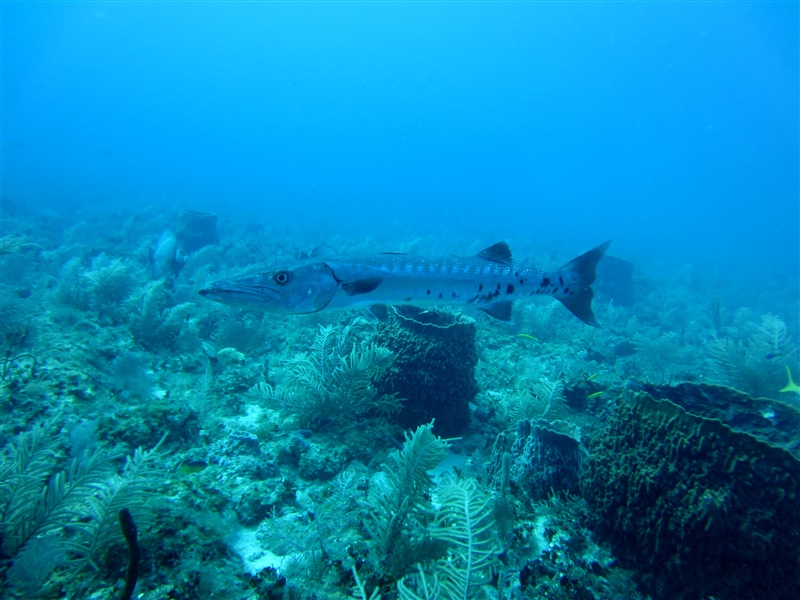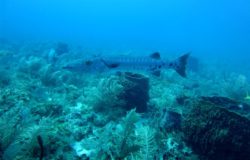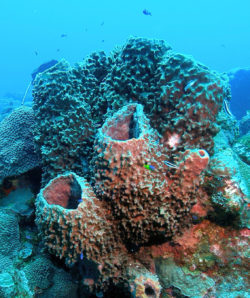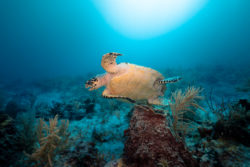
Sea Wonder: Giant Barrel Sponge
Giant barrel sponges (Xestospongia muta) are the largest sponges found in the Caribbean and the Gulf of Mexico, most commonly on coral reefs. Their large size and incredibly long lifespan earned them the nickname, “redwood of the reef”. They are one of the most-studied and well understood species of sponge in the ocean.

Barracuda swimming by a giant barrel sponge in Florida Keys National Marine Sanctuary. Photo: NOAA
Description
One of the world’s largest species of sponge, giant barrel sponges are aptly named for their size and cylindrical shape. These invertebrates can reach maximum diameters of six feet and can grow to heights of nearly eight feet. Atop their spongy bodies is an opening called the osculum, which they use to pass water back out into the ocean after it enters their bodies through their pores. Giant barrel sponges are porous organisms with a rough looking texture and that appear in a variety of colors, including hues of brown, red, purple, and brown-grey. The inside of their body cavities are tan in color. Like other sponges, the giant barrel sponge has a fragile, glass-like internal skeleton made of silicon and calcium carbonate. This type of skeleton is called a porifera skeleton. Unlike our cells, sponge cells can transform to perform different functions depending on the animal’s needs.
Diet & Habitat

Giant barrel sponges in Flower Garden Banks National Marine Sanctuary. Photo: NOAA
Sponges are passive feeders that filter the nutrients they need from the water around them. Water enters the giant barrel sponge’s body through its porous sides, and from there their cells move water through, eating bacteria and plankton suspended in the water and pulling in dissolved nutrients. As a result, water that exits the sponges as waste is cleaner than when it entered! This makes these otherwise plain looking organisms incredibly important to their ecosystems and food webs — without these sponges, bacteria and other organism populations would grow out of balance.
Giant barrel sponges can live in waters as deep as 390 feet or more, but are commonly found in waters that are around 33 feet deep. They inhabit coral reefs and sometimes the roots of mangrove forests and have a geographic range that spans throughout the Caribbean and the Gulf of Mexico, reaching as far south as Belize and as far north as Bermuda. Within the National Marine Sanctuary System, we see giant barrel sponges in Florida Keys and Flower Garden Banks national marine sanctuaries.
Life History
Giant barrel sponges can live hundreds or even thousands of years. They reproduce throughout the year by releasing sperm and egg cells from their osculums into the water column or in the bodies of other sponges, which then fuse to form embryos. Sponges are hermaphroditic, meaning they produce both sperm and egg cells. Larvae hatch shortly after and are carried by the ocean currents. Many of the larvae are eaten by larger plankton, fish, or other animals, but those that survive their first month move to the next stage in their life cycle. At this stage, they are strong enough to move on their own and find their settling place for the remainder of their lives. They generally live solitary lives, but small clusters of individuals are sometimes observed.
Threats & Conservation
Giant barrel sponge populations appear to be healthy, though they are not evaluated under the IUCN Red List. However, this species, and other sponges like it, experience the same threats as their coral neighbors — pollution, sedimentation, a changing climate, ocean acidification, coastal development, and blunt trauma from ships, fishing gear, or divers. In the Lower Keys of Florida, sediment are one of the main forms of damage to sponges – take a look for yourself in this video.

Hawksbill turtle swimming by a barrel sponge in Florida Keys National Marine Sanctuary. Photo: Alexander Neufeld
